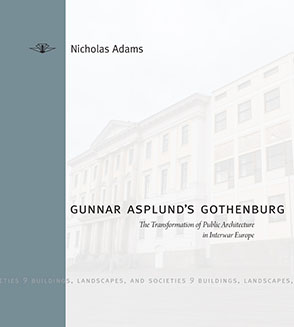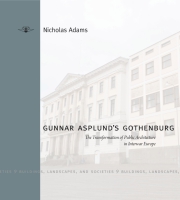
Gunnar Asplund's Gothenburg
The Transformation of Public Architecture in Interwar Europe
Nicholas Adams
Gunnar Asplund's Gothenburg
The Transformation of Public Architecture in Interwar Europe
Nicholas Adams
“In his penetrating and inspiring study, Nicholas Adams makes a contested provincial Swedish masterpiece the focus of a wide architectural and cultural context. He reveals the complexity of progressive modernity in relation to public monumental space, traditions, and institutional authority, viewing Asplund’s courthouse extension as both expression and functional scenography. His book adds substantially to Swedish architectural historiography and to the understanding of the international scene and their interrelationship.”
- Description
- Reviews
- Bio
- Table of Contents
- Subjects
“In his penetrating and inspiring study, Nicholas Adams makes a contested provincial Swedish masterpiece the focus of a wide architectural and cultural context. He reveals the complexity of progressive modernity in relation to public monumental space, traditions, and institutional authority, viewing Asplund’s courthouse extension as both expression and functional scenography. His book adds substantially to Swedish architectural historiography and to the understanding of the international scene and their interrelationship.”
“This brilliant book offers a unique insight into one of the most cherished models of modern monumentality: the Gothenburg Courthouse extension, designed by Swedish architect Gunnar Asplund and completed in 1936. Setting his subject in an international perspective, Nicholas Adams carefully addresses questions on modern law and modern architecture, reaching far beyond the actual case. Through his inclusively contextual approach, we learn that the introduction of modernism in public architecture was a difficult task, operating on different levels of a democratic society through the interplay of architect, commissioner, and—not least—public opinion.”
“Adams has given us a serious and well-researched book with much valuable translation from the Swedish and a welcome emphasis on social and political history.”
“Nicholas Adams achieves his own feat of construction by placing Asplund’s extension into a broader historiography of mid-twentieth-century modernism and by contextualizing the building’s reception and effect upon the development of attitudes about modernist architecture. That a scholar could write an entire study on one building’s extension, and hold the reader’s interest so intently throughout the process, is its own singular achievement.”
Nicholas Adams is Mary Conover Mellon Professor in the History of Architecture at Vassar College.
CONTENTS
LIST OF ILLUSTRATIONS
ACKNOWLEDGMENTS
LIST OF ABBREVIATIONS
A NOTE ON TRANSLATION
Introduction: Public Architecture in the Modern World
CHAPTER 1 Sweden: Gothenburg and Its Courthouse
CHAPTER 2 Asplund’s Multiple Visions, 1913–1937
CHAPTER 3 Asplund’s Building and Modern Law
CHAPTER 4 Asplund’s Reputation and the Catastrophic Reception
CHAPTER 5 Managing Modernisms at Home
CHAPTER 6 Public Architecture After Asplund
NOTES
BIBLIOGRAPHY
INDEX
Mailing List
Subscribe to our mailing list and be notified about new titles, journals and catalogs.



